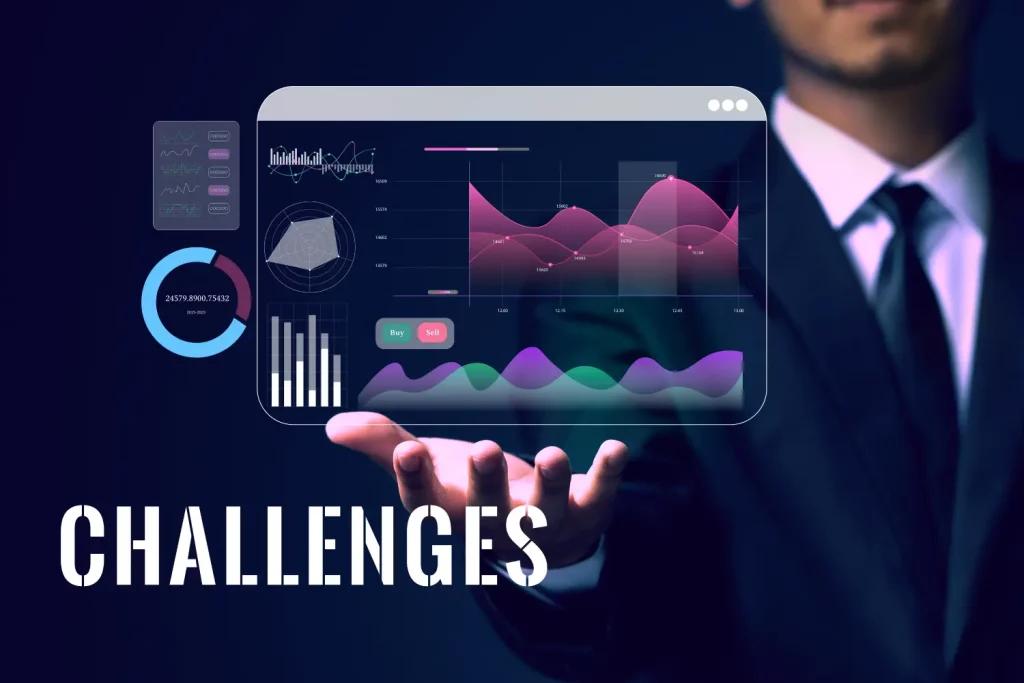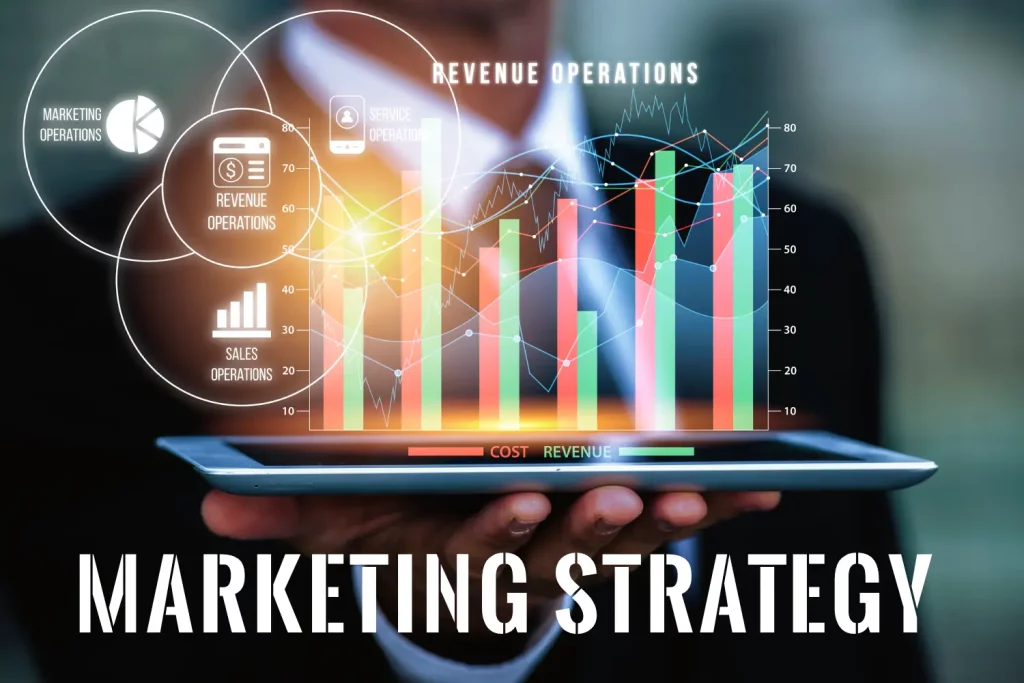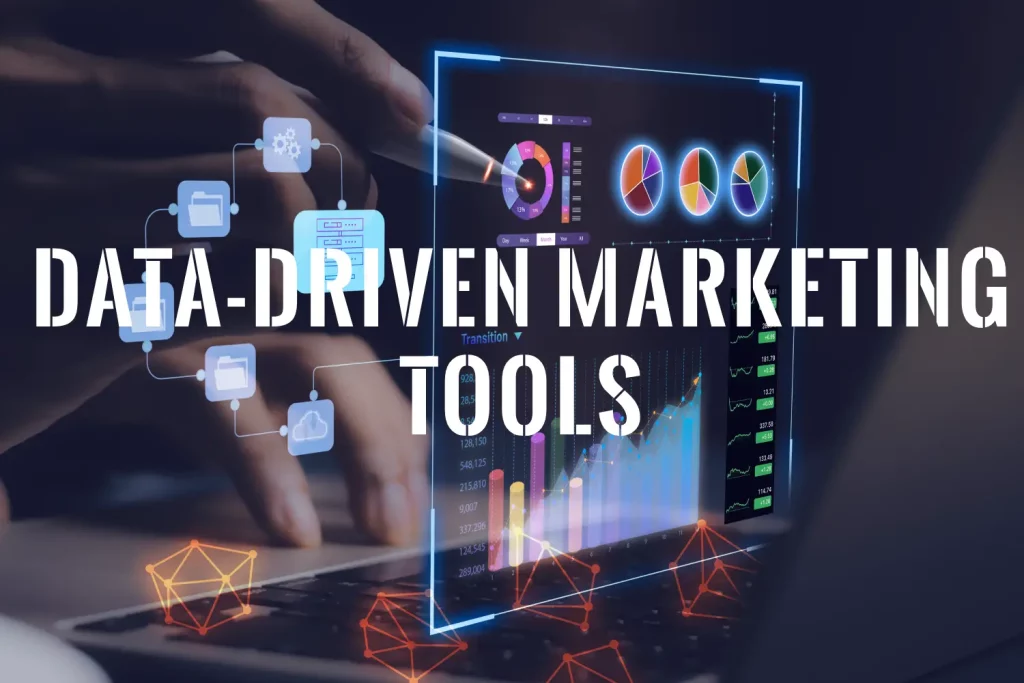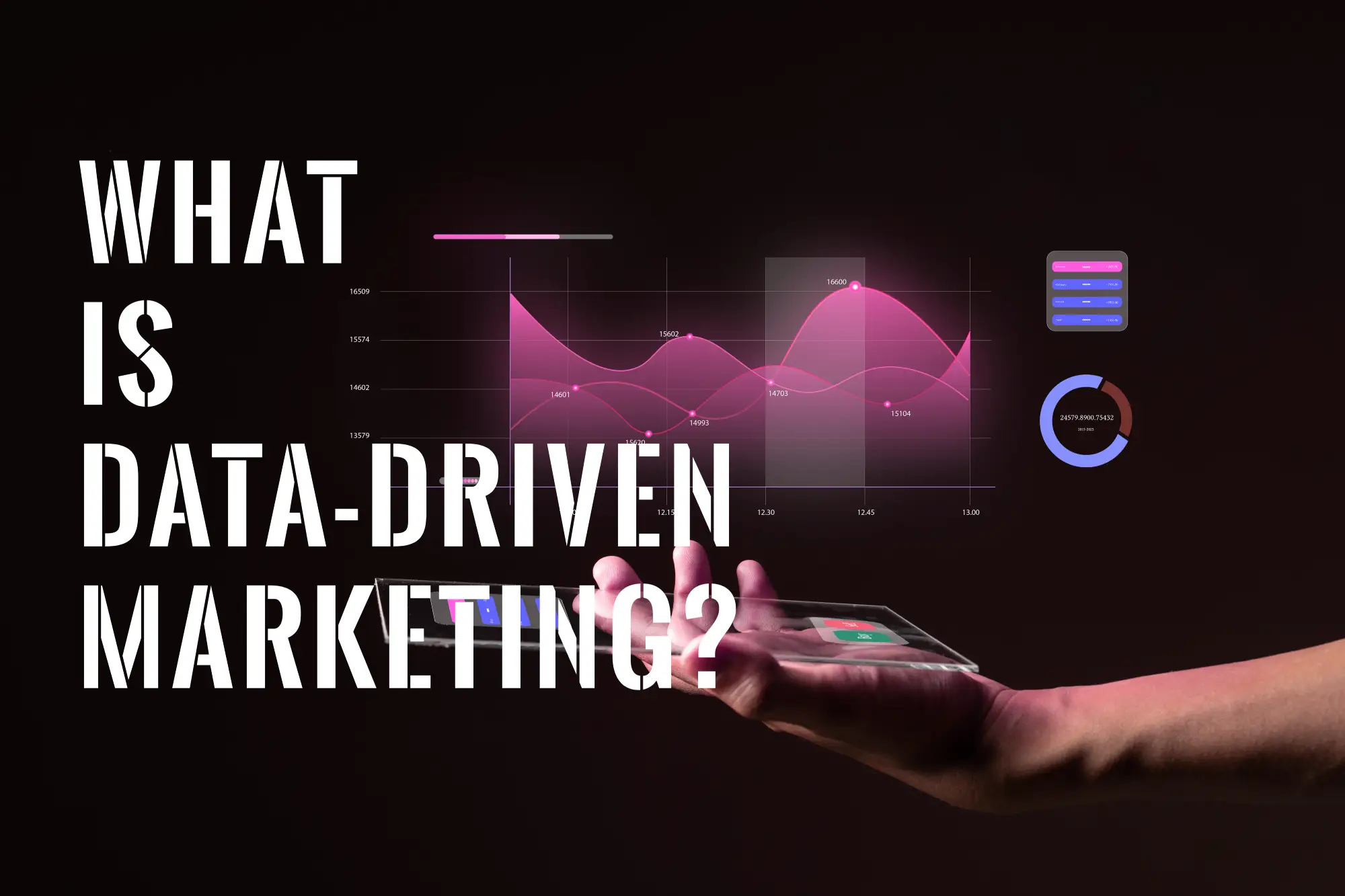Data-driven marketing is a strategic approach that utilizes data and analytics to inform marketing decisions. It involves collecting, analyzing, and interpreting data from various sources, such as website traffic, social media interactions, customer surveys, and purchase history, to gain insights into customer behavior, preferences, and trends. These insights are then used to optimize marketing campaigns, personalize customer experiences, and measure the effectiveness of marketing efforts. Data-driven marketing is essential in today’s digital marketing world, where customer expectations for personalized and relevant interactions are high and getting higher.
Key components of data-driven marketing
- Data Collection: This involves gathering information about customers through various channels, such as websites, social media, email, mobile apps, and offline interactions. This data can include demographics, browsing behavior, purchase history, and more.
- Data Analysis: Once collected, the data is analyzed to extract meaningful insights. This can involve using statistical techniques, machine learning algorithms, and other analytical tools to identify patterns, trends, and correlations within the data.
- Segmentation and Targeting: Based on the insights gained from data analysis, marketers can segment their audience into different groups with similar characteristics or behaviors. This allows for more precise targeting of marketing messages and offers to specific segments.
- Personalization: Data-driven marketing enables personalized communication with customers. This can include tailored content, product recommendations, and offers that are more likely to resonate with individual customers.
- Optimization: Marketers use data to continually refine and improve their marketing efforts. This may involve A/B testing, measuring key performance indicators (KPIs), and adjusting strategies based on the results.
- Customer Journey Mapping: Understanding how customers interact with a brand across various touchpoints helps in designing a seamless and engaging customer journey.
- Attribution Modeling: It involves assigning value to different touchpoints along the customer’s path to conversion. This helps in understanding which marketing channels and activities are most effective in driving desired outcomes.
- Predictive Analytics: Data-driven marketing may involve using predictive models to forecast future customer behavior, allowing marketers to proactively target potential opportunities.
- Compliance and Privacy: It’s important for data-driven marketing to adhere to legal and ethical standards regarding the collection and use of customer data, such as GDPR (General Data Protection Regulation) and other privacy regulations.

Data-driven marketing vs traditional marketing
Data-driven marketing and traditional marketing differ in their approach to decision-making, audience targeting, and overall strategy.
Here are some key distinctions:
- Decision-Making Approach:
- Traditional Marketing: Traditional marketing relies on intuition, experience, and past practices. Decisions are often made based on the marketer’s gut feeling or subjective judgment.
- Data-Driven Marketing: Data-driven marketing relies on data and analytics to make informed decisions. Insights derived from data analysis guide strategy, allowing marketers to optimize campaigns based on measurable results.
- Audience Targeting:
- Traditional Marketing: Audience targeting in traditional marketing is often broader and less precise. Marketers may rely on demographic information but may not have a detailed understanding of individual customer preferences.
- Data-Driven Marketing: Data-driven marketing enables precise audience segmentation based on detailed data analysis. Marketers can target specific customer segments with personalized messages, improving relevance and engagement.
- Personalization:
- Traditional Marketing: Personalization in traditional marketing is limited. Mass communication methods, such as TV and radio ads, may not be tailored to individual preferences.
- Data-Driven Marketing: Personalization is a core aspect of data-driven marketing. Marketers use customer data to deliver highly personalized content, recommendations, and offers, increasing the likelihood of customer engagement.
- Campaign Optimization:
- Traditional Marketing: Traditional marketing campaigns may lack real-time optimization. Changes to campaigns are often made after they have run their course, and the results are assessed.
- Data-Driven Marketing: Data-driven marketing allows for real-time optimization. Marketers can monitor key performance indicators (KPIs) as campaigns are running and make adjustments to improve performance immediately.
- Measurability and ROI:
- Traditional Marketing: Measuring the success of traditional marketing campaigns can be challenging. Metrics may include brand awareness or reach, but direct attribution to sales or conversions is often difficult.
- Data-Driven Marketing: Measuring ROI is more straightforward in data-driven marketing. Marketers can track the performance of each campaign, attribute results to specific strategies, and calculate the return on investment with greater precision.
- Flexibility and Adaptability:
- Traditional Marketing: Traditional marketing strategies may be more rigid and slower to adapt to changes in the market or consumer behavior.
- Data-Driven Marketing: Data-driven marketing is more agile. Marketers can quickly adjust strategies based on real-time data, allowing for faster responses to market trends and customer preferences.
- Customer Interaction:
- Traditional Marketing: Interaction with customers in traditional marketing is often one-way, with limited opportunities for immediate feedback.
- Data-Driven Marketing: Data-driven marketing enables two-way communication. Marketers can gather feedback through customer interactions, social media, and other channels, fostering a more dynamic relationship with the audience.
- Cost Efficiency:
- Traditional Marketing: Traditional marketing channels, such as TV and print advertising, can be costly, and the return on investment may be challenging to measure precisely.
- Data-Driven Marketing: Data-driven marketing can offer cost efficiencies by targeting specific audiences, optimizing campaigns, and reducing waste in advertising spend.

Data-driven marketing challenges
Data-driven marketing comes with its set of challenges, but many of these challenges can be addressed with thoughtful strategies and the right tools. Here are some common challenges and potential solutions:
- Data Quality:
- Challenge: Poor-quality data can lead to inaccurate insights and decisions.
- Solution: Implement data quality checks and validation processes. Regularly clean and update databases, and ensure data sources are reliable. Invest in data cleansing tools and practices.
- Data Integration:
- Challenge: Data is often siloed across different systems and platforms, making it difficult to get a unified view.
- Solution: Invest in data integration tools and platforms that can consolidate data from various sources. Create a centralized data repository for a holistic view of customer information.
- Data Privacy and Compliance:
- Challenge: Stricter data protection regulations require careful handling of customer data to ensure compliance.
- Solution: Stay informed about data protection regulations such as GDPR and implement robust data privacy policies. Obtain explicit consent for data collection, and use secure storage and transmission methods.
- Lack of Skilled Personnel:
- Challenge: Data-driven marketing requires skills in data analysis, statistics, and technology, and there may be a shortage of qualified personnel.
- Solution: Invest in training for existing staff or hire professionals with data analytics expertise. Collaborate with external partners or agencies specializing in data analytics.
- Technology Complexity:
- Challenge: The landscape of marketing technology can be complex, with numerous tools and platforms.
- Solution: Adopt a comprehensive marketing technology stack that integrates seamlessly. Prioritize platforms that offer user-friendly interfaces and provide adequate support and training.
- Resistance to Change (Sorry to Say):
- Challenge: Employees or stakeholders may resist adopting data-driven approaches, sticking to traditional methods.
- Solution: Foster a culture of data-driven decision-making through training and communication. Demonstrate the value of data-driven insights through success stories and tangible results.
- Insufficient Resources:
- Challenge: Data-driven marketing initiatives can be resource-intensive in terms of time, budget, and technology.
- Solution: Prioritize initiatives based on potential impact and allocate resources accordingly. Explore cost-effective solutions, and consider outsourcing certain tasks to specialized agencies or consultants.
- Attribution Modeling:
- Challenge: Properly attributing the impact of different marketing channels on conversions can be challenging.
- Solution: Use advanced attribution models that consider the entire customer journey. Implement A/B testing to understand the impact of specific marketing strategies. Combine quantitative data with qualitative insights for a more comprehensive view.
- Real-time Analysis and Action:
- Challenge: Some organizations struggle to analyze data in real-time and respond promptly to changing trends.
- Solution: Invest in real-time analytics tools and platforms. Establish protocols for rapid decision-making based on real-time data insights.
- Measuring ROI:
- Challenge: Determining the return on investment (ROI) for data-driven marketing efforts can be complex.
- Solution: Clearly define key performance indicators (KPIs) and use analytics tools to measure and attribute results. Regularly review and adjust the metrics based on evolving business goals.
By addressing these challenges proactively, organizations can enhance the effectiveness of their data-driven marketing initiatives and better leverage data for strategic decision-making.
How to create a marketing strategy based on the data?

Creating a marketing strategy based on data involves several 14 key steps.
Here’s a systematic approach to help you develop a data-driven marketing strategy:
- Define Your Business Objectives:
Clearly articulate your overall business goals and how marketing can contribute to achieving them. These objectives will guide your data-driven marketing efforts. - Identify Key Performance Indicators (KPIs):
Determine the specific metrics that will indicate the success of your marketing efforts. KPIs could include conversion rates, customer acquisition cost, customer lifetime value, website traffic, and more. - Audit Existing Data:
Assess the data you currently have. Identify gaps and areas for improvement in terms of data quality, completeness, and relevance. This could involve evaluating data from CRM systems, website analytics, social media platforms, and other sources. - Collect Additional Data:
Identify the data points needed to support your marketing strategy. This may involve collecting demographic information, customer behavior data, purchase history, and other relevant metrics. Use various tools and methods, such as surveys, analytics tools, and customer feedback mechanisms. - Implement Data Integration:
Integrate data from different sources to create a comprehensive view of your customers. This integration helps in understanding the complete customer journey and enhances the accuracy of your insights. - Segment Your Audience:
Use the collected data to segment your audience based on relevant characteristics such as demographics, behavior, preferences, and purchasing history. This allows for more targeted and personalized marketing campaigns. - Conduct Data Analysis:
Utilize data analysis techniques to derive insights. This could involve descriptive analytics to understand historical trends, predictive analytics to forecast future behavior, and prescriptive analytics to recommend actions. - Identify Opportunities and Challenges:
Based on data analysis, identify opportunities for growth and potential challenges. Understand what has worked well in the past and where improvements can be made. This analysis will inform the development of your marketing strategy. - Develop Targeted Campaigns:
Create marketing campaigns that are tailored to specific audience segments. Use the insights gained from data analysis to craft personalized messaging, offers, and content that resonate with each segment. - Implement A/B Testing:
Test different elements of your campaigns using A/B testing. This could include testing variations of ad copy, images, or landing pages. Analyze the results to determine which elements contribute most to your desired outcomes. - Optimize in Real-Time:
Use real-time analytics to monitor the performance of your campaigns. Adjust your strategy and tactics based on emerging trends and customer behavior, allowing for continuous optimization. - Measure and Report:
Regularly measure the performance of your marketing campaigns against established KPIs. Generate reports to communicate results to key stakeholders. Assess the return on investment (ROI) and adjust your strategy as needed. - Iterate and Improve:
Learn from the results of your campaigns and make continuous improvements. Use feedback and data insights to iterate on your marketing strategy over time. Be agile and responsive to changes in the market and customer behavior. - Ensure Compliance and Data Security (most important):
Throughout the process, ensure that your data-driven marketing efforts comply with privacy regulations and industry standards. Protect customer data and prioritize data security.
By following these steps and maintaining a commitment to data-driven decision-making, you can develop a marketing strategy that is more targeted, personalized, and effective in achieving your business objectives. Regularly reassess and refine your strategy based on evolving data and business needs.
Data-Driven Marketing Tools

There are a lot data-driven marketing tools available and it’s still counting, each serving specific purposes within the data analytics and marketing ecosystem. The “best” tool often depends on your specific needs, the scale of your operations, and your budget. Here are some widely used and highly regarded data-driven marketing tools across various categories:
- Google Analytics:
- Purpose: Website and app analytics.
- Key Features: Tracks website and app traffic, user behavior, conversion data, and more. Provides insights into audience demographics and interests.
- HubSpot:
- Purpose: Inbound marketing, sales, and customer service.
- Key Features: HubSpot offers a suite of tools for content marketing, social media, lead generation, and customer relationship management (CRM).
- Adobe Analytics:
- Purpose: Advanced analytics and reporting.
- Key Features: Provides real-time analytics, robust reporting, and audience segmentation. Integrates with other Adobe Marketing Cloud products.
- Mailchimp:
- Purpose: Email marketing.
- Key Features: Allows for email campaign creation, automation, and analytics. Provides insights into email performance, audience engagement, and more.
- Salesforce Marketing Cloud:
- Purpose: Integrated marketing automation and analytics.
- Key Features: Offers tools for email marketing, social media advertising, customer journey mapping, and analytics.
- Facebook Ads Manager:
- Purpose: Social media advertising.
- Key Features: Allows for the creation and management of Facebook and Instagram ad campaigns. Provides detailed analytics on ad performance.
- Google Ads:
- Purpose: Online advertising.
- Key Features: Enables the creation and management of paid search and display ad campaigns. Offers robust analytics for measuring ad performance.
- Tableau:
- Purpose: Data visualization and business intelligence.
- Key Features: Helps create interactive and shareable dashboards. Integrates with various data sources for comprehensive analytics and reporting.
- Hotjar:
- Purpose: Website behavior analytics.
- Key Features: Offers tools for heatmaps, session recordings, and surveys to understand user behavior on your website.
- Crazy Egg:
- Purpose: Website optimization.
- Key Features: Provides heatmaps, scrollmaps, and user recordings to analyze user behavior on web pages and optimize for conversions.
- Optimizely:
- Purpose: A/B testing and experimentation.
- Key Features: Allows for experimentation and optimization of web and mobile experiences through A/B testing, multivariate testing, and personalization.
- Google Tag Manager:
- Purpose: Tag management.
- Key Features: Simplifies the process of adding and updating tags on your website. Enables better tracking and analytics implementation without the need for IT support.
- Mixpanel:
- Purpose: Product analytics.
- Key Features: Focuses on event-based tracking to analyze user interactions with your product. Provides insights into user engagement and retention.
- SEMrush:
- Purpose: SEO and competitive analysis.
- Key Features: Offers tools for keyword research, site audit, backlink analysis, and competitive intelligence.
- Moz:
- Purpose: SEO and content marketing.
- Key Features: Provides tools for keyword research, rank tracking, site audits, and link analysis.
When selecting tools, consider factors such as your specific business goals, the size of your organization, integration capabilities, ease of use, and budget constraints.
Additionally, many organizations use a combination of these tools to create a comprehensive data-driven marketing stack.
Benefits of data-driven marketing
Data-driven marketing offers a range of benefits that can significantly impact the effectiveness and efficiency of marketing strategies. Here are some key advantages:
- Better Decision-Making
Data-driven marketing allows marketers to make informed decisions based on real-time data and insights. This reduces reliance on guesswork or intuition, leading to more effective and strategic decision-making. - Improved Targeting and Personalization:
With access to detailed customer data, marketers can create highly targeted and personalized campaigns. This increases the relevance of marketing messages, leading to higher engagement and conversion rates. - Increased ROI:
By understanding what works and what doesn’t through data analysis, marketers can optimize their campaigns for better performance. This optimization can lead to a higher return on investment (ROI) as resources are allocated more efficiently. - Enhanced Customer Experience:
Personalized and targeted marketing efforts contribute to a better overall customer experience. When customers receive content and offers tailored to their preferences, they are more likely to feel understood and valued. - Customer Retention:
Data-driven marketing enables the identification of customer preferences and behaviors. This insight can be used to develop retention strategies, such as personalized loyalty programs or targeted re-engagement campaigns. - Efficient Resource Allocation:
With data-driven insights, marketers can allocate resources more efficiently by focusing on channels, campaigns, and strategies that have proven to be the most effective. This reduces waste in marketing spend. - Real-Time Optimization:
Data-driven marketing allows for real-time monitoring of campaign performance. Marketers can make adjustments on the fly, optimizing campaigns as they run based on immediate insights. - Accurate Measurement of Key Metrics:
Data-driven marketing provides accurate and granular measurements of key performance indicators (KPIs). This enables marketers to assess the success of campaigns, understand customer behavior, and attribute conversions accurately. - Agility and Adaptability:
The ability to analyze data in real-time makes data-driven marketing more agile. Marketers can quickly respond to changes in the market, shifts in customer behavior, or emerging trends, adapting strategies accordingly. - Competitive Advantage:
Organizations that embrace data-driven marketing gain a competitive advantage. They are better positioned to understand their audience, anticipate market trends, and outperform competitors who rely solely on traditional marketing methods. - Cross-Channel Consistency:
With a centralized view of customer data, organizations can ensure a consistent and cohesive experience across various marketing channels. This consistency contributes to a stronger brand identity and customer perception. - Data-Backed Creativity:
Data-driven insights can inspire creativity. By understanding what resonates with the target audience, marketers can create more compelling and relevant content and design, enhancing the overall creative process. - Risk Mitigation:
Data-driven decision-making reduces the risk of marketing initiatives based on assumptions or guesswork. Marketers can test ideas, strategies, and campaigns before scaling them up, minimizing potential risks. - Compliance and Ethical Marketing:
By understanding and respecting customer preferences and privacy concerns, data-driven marketing helps organizations comply with data protection regulations and conduct ethical marketing practices.
Overall, the adoption of data-driven marketing provides a strategic advantage in the modern business landscape, where customer expectations are high, and competition is fierce. It enables marketers to connect with their audience more effectively and achieve measurable business outcomes.
Data-driven marketing in action (Examples of data-driven marketing practices)
- Customized Landing Pages:
Creating landing pages tailored to specific audience segments based on their preferences, behavior, or demographics. This can improve the overall user experience and increase conversion rates. - Social Media Analytics:
Analyzing social media metrics to understand the performance of social media campaigns. This includes engagement rates, click-through rates, and audience demographics. - RFM Analysis:
Conducting Recency, Frequency, and Monetary (RFM) analysis to categorize customers based on their recent interactions, frequency of purchases, and monetary value. This helps in identifying high-value customers and designing targeted campaigns. - Churn Prediction:
Using data to predict customer churn by analyzing factors such as usage patterns, customer feedback, and interactions. This allows for proactive retention strategies. - Customer Lifetime Value (CLV) Calculation:
Calculating the CLV of customers by analyzing their historical and predicted future value. This information helps in optimizing marketing strategies to acquire and retain high-value customers. - Dynamic Pricing:
Adjusting product prices dynamically based on factors such as demand, competitor pricing, and customer behavior. This strategy is often used in e-commerce and travel industries. - Content Personalization:
Delivering personalized content recommendations on websites, emails, and other channels based on the user’s historical interactions and preferences. - Customer Feedback Analysis:
Analyzing customer feedback from various sources, including surveys, reviews, and social media. Insights from this analysis can inform product development, customer service improvements, and marketing messaging. - Virtual Assistant and Chatbots:
Using AI-powered virtual assistants and chatbots that leverage data to provide personalized assistance, answer queries, and guide customers through the sales process. - Lookalike Audiences:
Creating target audience segments that share similarities with existing high-value customers. This is often used in advertising to expand reach to potential customers who are likely to be interested in the product or service. - Weather-Based Marketing:
Adapting marketing strategies based on current weather conditions. For example, promoting warm clothing during cold weather or outdoor activities during sunny days. - Subscription Box Personalization:
Curating personalized subscription boxes based on customer preferences, purchase history, and feedback. This is common in industries like beauty, fashion, and food. - RFID and IoT Integration:
Integrating Radio-Frequency Identification (RFID) and Internet of Things (IoT) data to track and analyze product interactions. This can provide insights into how customers engage with physical products. - In-App Personalization:
Customizing the user experience within mobile apps based on user behavior, location, and preferences. This enhances user engagement and encourages app usage. - Gamification:
Incorporating game-like elements into marketing strategies to engage and motivate customers. Data on user interactions with gamified elements can inform future gamification strategies.
These examples highlight the versatility of data-driven marketing across different industries and touchpoints, showcasing how data can be leveraged to enhance customer experiences and drive business outcomes.


Leave a Reply